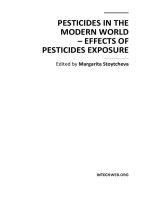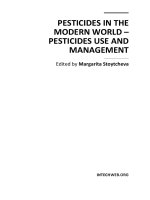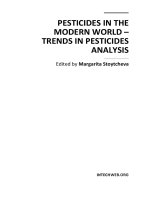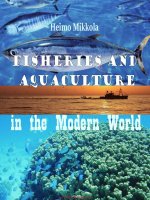PESTICIDES IN THE MODERN WORLD – TRENDS IN PESTICIDES ANALYSIS docx
Bạn đang xem bản rút gọn của tài liệu. Xem và tải ngay bản đầy đủ của tài liệu tại đây (24.05 MB, 526 trang )
PESTICIDES IN THE
MODERN WORLD –
TRENDS IN PESTICIDES
ANALYSIS
Edited by Margarita Stoytcheva
Pesticides in the Modern World – Trends in Pesticides Analysis
Edited by Margarita Stoytcheva
Published by InTech
Janeza Trdine 9, 51000 Rijeka, Croatia
Copyright © 2011 InTech
All chapters are Open Access articles distributed under the Creative Commons
Non Commercial Share Alike Attribution 3.0 license, which permits to copy,
distribute, transmit, and adapt the work in any medium, so long as the original
work is properly cited. After this work has been published by InTech, authors
have the right to republish it, in whole or part, in any publication of which they
are the author, and to make other personal use of the work. Any republication,
referencing or personal use of the work must explicitly identify the original source.
Statements and opinions expressed in the chapters are these of the individual contributors
and not necessarily those of the editors or publisher. No responsibility is accepted
for the accuracy of information contained in the published articles. The publisher
assumes no responsibility for any damage or injury to persons or property arising out
of the use of any materials, instructions, methods or ideas contained in the book.
Publishing Process Manager Sandra Bakic
Technical Editor Teodora Smiljanic
Cover Designer Jan Hyrat
Image Copyright flashgun, 2010. Used under license from Shutterstock.com
First published September, 2011
Printed in Croatia
A free online edition of this book is available at www.intechopen.com
Additional hard copies can be obtained from
Pesticides in the Modern World – Trends in Pesticides Analysis,
Edited by Margarita Stoytcheva
p. cm.
ISBN 978-953-307-437-5
free online editions of InTech
Books and Journals can be found at
www.intechopen.com
Contents
Preface IX
Part 1 Pesticides: Overview 1
Chapter 1 Identity, Physical and Chemical Properties of Pesticides 3
Zacharia, James Tano
Chapter 2 Thermodynamic Properties and Crystallization
Behavior of Pesticide Imidacloprid 21
Zhou Cairong
Chapter 3 Photolysis of Some Benzimidazole Based Pesticides 43
Yaser A. Yousef and Talal. S. Akasheh
Chapter 4 Pesticides Empty Containers (EPC) in
the Area of Ouagadougou: Actors, Risks
and Prospects of Secure Management 54
Gomgnimbou P.K Alain and Ouédraogo W. Osée
Chapter 5 Electrochemical Detoxification
of Obsolete Pesticides Stocks 71
R. Salghi, M. Errami, B. Hammouti and L. Bazzi
Chapter 6 Advances in Analytical Methods for
Organophosphorus Pesticide Detection 93
Tova A. Samuels and Sherine O. Obare
Chapter 7 Organophosphorus Pesticides Analysis 143
Margarita Stoytcheva and Roumen Zlatev
Chapter 8 New Methodologies for Assessing
the Presence and Ecological Effects of
Pesticides in Doñana National Park (SW Spain) 165
Carmen Pueyo, José-Luis Gómez-Ariza, Miguel-Angel Bello-López,
Rut Fernández-Torres, Nieves Abril, José Alhama,
Tamara García-Barrera and Juan López-Barea
VI Contents
Part 2 Chromatographic Pesticides Analysis 197
Chapter 9 Modern Sample Preparation
Techniques for Pesticide Analysis 199
Lesego C. Mmualefe, Christopher Mpofu and Nelson Torto
Chapter 10 Modern Extraction Techniques for Pesticide
Residues Determination in Plant and Soil Samples 221
Rada Ðurović and Tijana Ðorđević
Chapter 11 Cloud Point Extraction of Pesticide Residues 247
Hayati Filik and Sema Demirci Çekiç
Chapter 12 Determination of Pesticides in Complex Samples
by One Dimensional (1D-), Two-Dimensional (2D-)
and Multidimensional Chromatography 281
Tomasz Tuzimski
Chapter 13 Recent Techniques Applied for Pesticides
Identification and Determination in Natural
Products and Its Impact to Human Health Risk 319
Abd El-Moneim M.R. Afify
Chapter 14 Pesticide Residues in Natural Products with Pharmaceutical
Use: Occurrence, Analytical Advances and Perspectives 357
Andrés Pérez-Parada, Marcos Colazzo, Natalia Besil,
Eduardo Dellacassa, Verónica Cesio, Horacio Heinzen
and Amadeo R. Fernández-Alba
Chapter 15 Non-Targeted Analyses for Pesticides
Using Deconvolution, Accurate Masses, and
Databases – Screening and Confirmation 391
Chin-Kai Meng, Mike Szelewski, Jerry Zweigenbaum,
Peter Fürst and Eva Blanke
Chapter 16 Applications of Hadamard Transform-Gas
Chromatography/Mass Spectrometry (HT-GC/MS)
to the Detection of Pesticides in Rice 413
Cheng-Huang Lin and Chien-Hung Lin
Chapter 17 Highlights of Mass Spectrometric
Methodologies in Environmental Pollution 425
Mohamed Attya, Brunella Cavaliere, Fabio Mazzotti,
Antonio Tagarelli and Giovanni Sindona
Part 3 Emerging Methods of Pesticides Analysis 451
Chapter 18 Chemically Modified Electrodes
for Detection of Pesticides 453
Ayanthi Navaratne and Namal Priyantha
Contents VII
Chapter 19 Voltammetric Analysis of Pesticides 465
Ignas Tonle K. and Emmanuel Ngameni
Chapter 20 The Potential of Flow-Based Optosensing
Devices for Pesticide Assessment 489
Maria Luisa Fernández-de Córdova and Pilar Ortega-Barrales
Preface
Volume 1 of the unique book series “Pesticides in the Modern World” is a collection of
20 chapters addressing issues associated with pesticides detection, identification,
characterisation, and determination, organized in three sections.
Chapters 1-3 included in the first book section provide on overview on the recognized
principles for pesticides classification, and supply detailed data on pesticides physical
properties (vapour pressure, solubility, soil adsorption coefficient, specific
characteristics), and chemical interactions including oxidation, reduction, hydrolysis,
and photolysis. The thermodynamic properties of imidacloprid in particular are
investigated in order to solve the problem of its separation and purification.
Environmental risks and safe pesticides management topics are discussed in Chapter
4. The electrochemical oxidation as a method of detoxification of obsolete pesticides
stocks is suggested in Chapter 5.
Chapters 6 and 7 offer an exhaustive revision of the advanced chromatographic and
alternative sensors and biosensors-based methods for organophosphorus pesticides
determination. Chapter 8 comments on the improvement of the sensitivity and
selectivity of some chromatographic techniques for pesticides analysis, and on the
utility of the environmental proteomic approach in environmental pollutants
assessment.
The second book section is devoted to the chromatographic pesticides quantification.
Chapters 9-11 discuss various strategies for sample preparation, with emphasis on the
processes of extraction. The basic principles of the modern extraction techniques, such
as: accelerated solvent extraction, supercritical fluid extraction, microwave assisted
extraction, solid phase extraction, solid phase microextraction, matrix solid phase
dispersion extraction, cloud point extraction, and QuEChERS are comprehensively
described and critically evaluated. The recent advances in the multidimensional
chromatographic separation techniques are highlighted in Chapter 12. Chapters 13
and 14 cover topics on pesticides residues analysis in natural products, including
sample preparation procedures. In Chapter 15 it is presented the deconvolution
approach in the non-targeted pesticide analysis, allowing trace level pesticides
determination. The application of the Hadamard transformation to gas
chromatography/mass spectrometry for the sensitive detection of pesticides in rice is
X Preface
commented in Chapter 16. The efficiency of gas chromatography/mass spectrometry is
discussed in Chapter 17.
The third book section (Chapters 18-20) describes some alternative analytical
approaches to the conventional methods of pesticides determination. These include
voltammetric techniques making use of electrochemical sensors and biosensors, and
solid-phase spectrometry combined with flow-injection analysis applying flow-based
optosensors. Their remarkable analytical features are associated with the simple
operation procedure without or with a minimum sample pretreatment, and the high
sensitivity of the determinations.
Overall, the book offers a professional look on the recent achievements and emerging
trends in pesticides analysis. It could act as an excellent reference for the specialists,
involved in pesticides detection, identification, and determination.
All the contributing authors are gratefully acknowledged for their time and efforts in
preparing the different chapters, and for their interest in the present project.
Margarita Stoytcheva, Ph.D.
Institute of Engineering
Mexicali, Baja California
Mexico
Part 1
Pesticides: Overview
1
Identity, Physical and Chemical
Properties of Pesticides
Zacharia, James Tano
University of Dar es Salaam, Dar es Salaam University College of Education
Tanzania
1. Introduction
1.1 Definition of pesticide
According to FAO (1989) a pesticide is any substance or mixture of substances intended for
preventing, destroying, or controlling any pest including vectors of human or animal
diseases, unwanted species of plants or animals causing harm during, or otherwise
interfering with, the production, processing, storage, or marketing of food, agricultural
commodities, wood and wood products, or animal feedstuffs, or which may be
administered to animals for the control of insects, arachnids or other pests in or on their
bodies. The term includes chemicals used as growth regulators, defoliants, desiccants, fruit
thinning agents, or agents for preventing the premature fall of fruits, and substances applied
to crops either before or after harvest to prevent deterioration during storage or transport.
The term, however excludes such chemicals used as fertilizers, plant and animal nutrients,
food additives and animal drugs. The term pesticide is also defined by FAO in collaboration
with UNEP (1990) as chemicals designed to combat the attacks of various pests and vectors
on agricultural crops, domestic animals and human beings. The definitions above imply
that, pesticides are toxic chemical agents (mainly organic compounds) that are deliberately
released into the environment to combat crop pests and disease vectors.
1.2 Historical background of pesticides use in agriculture and public health
The historical background of pesticides use in agriculture is dated back to the beginning of
agriculture itself and it became more pronounced with time due to increased pest
population paralleled with decreasing soil fertility (Muir, 2002). However, the use of
modern pesticides in agriculture and public health is dated back to the 19
th
century. The first
generation of pesticides involved the use of highly toxic compounds, arsenic (calcium
arsenate and lead arsenate) and a fumigant hydrogen cyanide in 1860's for the control of
such pests like fungi, insects and bacteria. Other compounds included Bordeaux mixture
(copper sulphate, lime and water) and sulphur. Their use was abandoned because of their
toxicity and ineffectiveness. The second generation involved the use of synthetic organic
compounds. The first important synthetic organic pesticide was
dichlorodiphenyltrichloroethane (DDT) first synthesized by a German scientist Ziedler in
1873 (Othmer, 1996) and its insecticidal effect discovered by a Swiss chemist Paul Muller in
Pesticides in the Modern World – Trends in Pesticides Analysis
4
1939. In its early days DDT was hailed as a miracle because of its broad-spectrum activity,
persistence, insolubility, inexpensive and ease to apply (Keneth, 1992).
P, p’-DDT in particular was so effective at killing pests and thus boosting crop yields and
was so inexpensive to make its use quickly spread over the globe. DDT was also used for
many non-agricultural applications as well. For example, it was used to delouse soldiers in
the World War II and in the public health for the control of mosquitoes which are the
vectors for malaria. Following the success of DDT, such other chemicals were synthesized to
make this era what Rachel Carson (1962) in her book "The Silent Spring" described as the era
of "rain of chemicals
”
.
The intensive use of pesticides in agriculture is also well known to be coupled with the
"green revolution". Green revolution was a worldwide agricultural movement that began in
Mexico in 1944 with a primary goal of boosting grain yields in the world that was already in
trouble with food supply to meet the demand of the then rapidly growing human
population. The green revolution involved three major aspects of agricultural practices,
among which the use of pesticides was an integral part. Following its success in Mexico,
green revolution spread over the world. Pest control has always been important in
agriculture, but green revolution in particular needed more pesticide inputs than did
traditional agricultural systems because, most of the high yielding varieties were not widely
resistant to pests and diseases and partly due to monoculture system (Vocke, 1986). Each
year pests destroy about 30-48% of world’s food production. For example, in 1987 it was
reported that, one third of the potential world crop harvest was lost to pests. A further
illustration to the pest problem in the world is shown in table 1.1 (Hellar, 2002).
Insect pests and rodents also account for a big loss in stored agricultural products. Internally
feeding insects feed on grain endosperm and the germ the result of which is the loss in grain
weight, reduction in nutritive value of the grain and deterioration in the end use quality of
the grain. Externally feeding insects damage grain by physical mystification and by
excrement contamination with empty eggs, larval moults and empty cacoons.
A common
means of pest control in stored agricultural products has always been the use of insecticides
such as malathion, chlorpyrifos-methyl or deltamethrin impregnated on the surfaces of the
storage containers (McFarlane, 1989).
On the other hand malaria remains the major vector-borne infectious disease in many parts
of the tropics. It is estimated that over 300 to 500 million clinical cases occur each year, with
cases in tropical Africa accounting for more than 90% of these figures (WHO, 1995).
Other
vector-borne diseases that present a serious problem especially in the tropics include
trypanosomiasis, onchocerciasis and filariasis. It is therefore quite apparent that, the
discovery of pesticides was not a luxury of a technical civilization but rather was a necessity
for the well being of mankind.
Identity, Physical and Chemical Properties of Pesticides
5
Crop
Estimated % Losses
Insects Diseases Weeds Total
Rice 26.7 8.9 10.8 46.4
Maize 12.4 9.4 13.0 34.8
Wheat 5.0 9.1 9.8 23.9
Millet 9.6 10.6 17.8 38.0
Potatoes 6.5 21.8 4.0 32.3
Cassava 7.7 16.6 9.2 33.5
Soybeans 4.5 11.1 13.5 29.1
Peanuts 17.1 11.3 11.8 40.4
Sugarcane 9.2 10.7 25.1 45.0
Table 1.1 Estimated % losses caused by pests in some world's major crops per year
1.3 Impacts of pesticides use in agriculture and public health
The use of pesticides in agriculture has led to a significant improvement in crop yield per
hectare of land. Studies have established a possible correlation relationship between the
quantity of pesticides used per hectare and the amount of crop yields per hectare (Hellar,
2002); table 1. 2. Pesticides like DDT and others proved their usefulness in agriculture and
public health. Economies were boosted, crop yields were tremendously increased, and so
were the decreases in fatalities from insect-borne diseases. Insecticides have saved the lives
of countless millions of people from insect-borne diseases (Youdeowei, 1983).
1.4 Side effects of pesticides use to the environment and public health
Despite the good results of using pesticides in agriculture and public health described
above, their use is usually accompanied with deleterious environmental and public health
effects. Pesticides hold a unique position among environmental contaminants due to their
high biological activity and toxicity (acute and chronic). Although some pesticides are
described to be selective in their modes of action, their selectivity is only limited to test
animals. Thus pesticides can be best described as biocides (capable of harming all forms of
life other than the target pest). Further details on the side effects of pesticides are discussed
inthe following chapter (ecological effects of pesticides).
Country/Area Pesticide Use (kg/Ha) Crop Yield (Ton/Ha)
Japan 10.8 5.5
Europe 1.9 3.4
USA 1.5 2.6
Latin America 0.2 2.0
Oceania 0.2 1.6
Africa 0.1 1.2
Table 1.2 Pesticides use and the corresponding crop yield in some countries/areas
Pesticides in the Modern World – Trends in Pesticides Analysis
6
2. Identity of pesticides
2.1 How can pesticides be identified?
Many of the pesticides that we use in our crops, gardens or domestic animals, are often a
mixture of several chemicals mixed together in desired proportions suspended in appropriate
carrier or diluent materials. These chemicals are called active ingredients that are responsible
for killing or otherwise affecting the pests. Apart from the active ingredients, there are other
chemicals that are formulated together with the active ingredients that usually do not kill
pests. These are called inert ingredients that serve as carriers, diluents, binders, dispersants,
prolong the shelf life of active ingredients or make the pesticide smell better. It is often the case
that active ingredients on the container labels are named using common names. However,
common names are not the only way to identify pesticides and in fact common names do not
give complete information on the chemical nature of the pesticides. When chemists want to
give a specific and unambiguous name to a chemical, they use what is called “systematic
name”. These names are usually long and complicated, but they are necessary for naming the
millions of known chemicals. There are two main systems for deriving the systematic names of
chemicals, one from the International Union of Pure and Applied Chemistry (IUPAC) and the
other from the Chemical Abstracts Service (CAS). As an example of the two systematic naming
described above, the following insecticide is names respective as;
IUPAC systematic name: (E)-1-(6-chloro-3-pyridylmethyl)-N-nitroimidazolidin-2-
ylideneamine
The same insecticide has the following CAS systematic name:
(2E)-1-[(6-chloro-3-pyridinyl)methyl]-N-nitro-2-imidazolidinimine
In addition to a systematic name, CAS assigns a registry number to each chemical which is
different from one chemical to another. For example the insecticide just described above has
a CAS registry number of 138261-41-3
As pointed out earlier, systematic names are long and complicated for a mere user of
pesticides (layman). For that matter, systematic names are more used by experts in the field
of pesticides who pursue specific researches in which a proper identification of the chemical
is needed. For many purposes, a relatively short and simple name would be helpful than a
systematic name or registry number, and that is the role of common names.
2.2 How are the common names of pesticides derived?
What most people need when reading, writing or talking about a pesticides is a short, fairly
simple and reasonably memorable name. Common names are approved by the International
Organization for Standardization (ISO) based on given guidelines. For example the common
name for the insecticide (E)-1-(6-chloro-3-pyridylmethyl)-N-nitroimidazolidin-2-
ylideneamine is given as “imidacloprid” derived from parts of the systematic name. The
process of registering common names usually starts with the pesticides manufacturers
submitting proposals for names to ISO and the ISO committee checks that the proposed
names comply with the rules, not misleading, and are not likely to be confused with the
existing names of pesticides or drugs. Once common names are approved by ISO, they no
longer belong to the company, but rather they can be used in other countries.
2.3 Classification of pesticides
The word "pesticide" is an umbrella term for all insecticides, herbicides, fungicides,
rodenticides, wood preservatives, garden chemicals and household disinfectants that may
Identity, Physical and Chemical Properties of Pesticides
7
be used to kill some pests. Since pesticides varies in identity, physical and chemical
properties, it`s therefore logical to have them classified and their properties studied under
their respective groups. Synthetic pesticides are classified based on various ways depending
on the needs. However, there are three most popular ways of classifying pesticides which
are; classification based on the mode of action, classification based on the targeted pest
species and classification based on the chemical composition of the pesticide (Drum, 1980).
2.3.1 Classification of pesticides based on the mode of action
Under this type of classification, pesticides are classified based on the way in which they act
to bring about the desired effect. In this way pesticides are classified as contact (non-
systemic) and systemic pesticides. The non-systemic pesticides are those that do not
appreciably penetrate plant tissues and consequently not transported within the plant
vascular system. The non systemic pesticides will only bring about the desired effect when
they come in contact with the targeted pest, hence the name contact pesticides. Examples of
contact pesticides are paraquat and diquat dibromide. On the other hand, the systemic
pesticides are those which effectively penetrate the plant tissues and move through the plant
vascular system in order to bring about the desired effect. Examples of systemic pesticides
include 2, 4-D and glyphosate (Buchel, 1983). Under this classification, aslo are stomach
poisons that bring about the desired effect after being eaten eg. Rodenticides. Fumigants are
those pesticides that produce vapour which kills the pests.
2.3.2 Classification of pesticides based on the targeted pest species
In this type of classification, pesticides are named after the name of the corresponding pest
in target as shown in table 2.1
Type of pesticide Target organism/pest
Insecticides Insects
Herbicides Weeds
Rodenticides Rodents
Fungicides Fungi
Acaricides and Miticides Arachnids of the order Acarina such as ticks and Mites
Molluscicides Mollusks
Bactericides Bacteria
Avicides Bird pests
Virucides Virus
Algicides Algae
Table 2.1 Classification of pesticides based on the target organisms
2.3.3 Classification of pesticides based on the chemical composition
Under chemical classification, pesticides are categorized according to the chemical nature of
the active ingredients. The chemical classification of pesticides is by far the most useful
classification to reaserchers in the field of pesticides and environment and to those who
search for details. This is because, it is from this kind of classification that gives the clue of
the effficacy, physical and chemical properties of the respective pesticides, the knowledge of
which is very important in the mode of application, precautions that need to be taken
Pesticides in the Modern World – Trends in Pesticides Analysis
8
during application and the application rates. Based on chemical classification, pesticides are
classified into four main groups namely; organochlorines, organophosphorous, carbamates
and pyrethrin and pyrethroids (Buchel, 1983).
Organochlorines pesticides are organic compounds with five or more chlorine atoms.
Organochlorines were the first synthetic organic pesticides to be used in agriculture and in
public health. Most of them were widely used as insecticides for the control of a wide range
of insects, and they have a long-term residual effect in the environment since they are
resistant to most chemical and microbial degradations. Organochlorine insecticides act as
nervous system disruptors leading to convulsions and paralysis of the insect and its
eventual death. Some of the commonly used representative examples of organochlorine
pesticides are DDT, lindane, endosulfan, aldrin, dieldrin and chlordane and their chemical
structures are presented hereunder.
Organophosphorous insecticides on the other hand contain a phosphate group as their basic
structural framework as defined by Schrader's formula:
Where, R
1
and R
2
are usually methyl or ethyl groups, the O in the OX group can be replaced
with S in some compounds, whereas the X group can take a wide diversity of forms.
Organophosphorous insecticides are generally more toxic to vertebrates and invertebrates as
cholinesterase inhibitors leading to a permanent overlay of acetylcholine neurotransmitter
across a synapse. As a result, nervous impulses fail to move across the synapse causing a
rapid twitching of voluntary muscles and hence paralysis and death. Unlike
organochlorines, organophosphorous insecticides are easily decomposed in the
Identity, Physical and Chemical Properties of Pesticides
9
environment by various chemical and biological reactions, thus organophosphorous
insecticides are not persistent in the environment (Martin, 1968). Some of the widely used
organophosphorous insecticides include parathion, malathion, diaznon and glyphosate.
Carbamates are organic pesticides derived from carbamic acid with the general formula
Where, R
1
is an alcohol group, R
2
is a methyl group and R
3
is usually hydrogen. Both oxime
and aryl carbamates have fairly high insect and mammalian toxicities as cholinesterase
inhibitors. The cholinesterase inhibitions of carbamates differ from that of
organophosphorous in that, it is species specific and it is reversible (Drum, 1980). Some of
the widely used insecticides under this group include carbaryl, carbofuran and aminocarb.
Pyrethroids are synthetic analogues of the naturally occurring pyrethrins; a product of
flowers from pyrethrum plant (Chrysanthemum cinerariaefolium). The insecticidal components
of pyrethrum flowers are the optically active esters derived from (+)-trans-chrysanthemic
acid and (+)-trans-pyrethroic acid.
Pesticides in the Modern World – Trends in Pesticides Analysis
10
Pyrethroids are acknowledged of their fast nocking down effect against insect pests, low
mammalian toxicity and facile biodegradation. Although the naturally occurring pyrethrins
are effective insecticides, their photochemical degradation is so rapid that their uses as
agricultural insecticides become impractical. The synthetic analogues of the naturally
occurring pyrethrins (pyrethroids) were developed by the modification of pyrethrin
structure by introducing a biphenoxy moiety and substituting some hydrogens with
halogens in order to confer stability at the same time retaining the basic properties of
pyrethrins. The most widely used synthetic pyrethroids include permethrin, cypermethrin
and deltamethrin.
Other miscelenious groups of pesticides that are worth mentioning particularly in this book
include among others phenoxyacetic acid under which the herbicide 2,4-D belongs and
bipyridyls under which the herbicides paraquat and diquat belong.
Identity, Physical and Chemical Properties of Pesticides
11
Fungicides are pesticides that are used for the control of fungal infections in crops. There are
inorganic and organic fungicides. Inorganic fungicides include Bordeaux mixture,
Cu(OH)
2
.CaSO
4
and malachite, Cu(HO)
2
.CuCO
3
. Organic fungicides on the other hand
include among others, benomyl and oxine copper (Manahan, 2001).
2.3.4 Other minor classes of pesticides
2.3.4.1 Activity spectrum of the pesticide
In this system of classification, pesticides are classified into two groups as broad spectrum
pesticides and selective pesticides. Broad spectrum pesticides are those pesticides that are
designed to kill a wide range of pests and other non target organisms. They are non-
selective and are often lethal to reptiles, fish, pets and birds. Some examples of broad
spectrum pesticides are chlorpyrifos and chlordane. Selective pesticides on the other hand
are those pesticides which kill only a specific or group of pests leaving other organisms with
a little or no effect at all. A good example in this case is a herbicide 2,4-D which affects
broad-leaved plants leaving the grassy crops unaffected.
2.3.4.2 Mode of formulation
Emulifiable concentrates (EC) are fine suspensions of oil droplets in water and appears
milky in colour. They do not require constant agitation prior to each application.
Wettable Powders (WP) are suspensions of fine particles suspended in water. These
suspension require constant agitation prior to each application.
Granules (G). Granules are obtained by mixing the active ingredient with clay for outdoor
applications.
Baits. These are obtained by mixing the active ingredient with food base especially used for
the control of rodents.
Dusts (D). Dusts cannot be mixed with water and they must be applied dry. The common
carriers for dusts are clay, talc, silica gel or diatomacious earth.
Fumigants. These are gaseous insecticides usually packaged under pressure and stored as
liquids. Some are tablets or pellets that release gas when mixed with water.
2.3.4.3 Toxicity level
The World Health Organization (WHO) has developed a classification system that group
pesticides according to the potential risks to human health caused by accidental contact to
human being and they are grouped into the following classes;
Class Ia = extremely hazardous
Class Ib = highly hazardous
Class II = moderately hazardous
Pesticides in the Modern World – Trends in Pesticides Analysis
12
Class III = slightly hazrdous
Class IV = products unlikely to present acute hazard in normal use
3. Physical properties of pesticides
The biological activity of a pesticide to the target pest species is greately influenced by its
physical and chemical properties. The physical properties of a pesticide in particular
determine the pesticide mode of action, dosage, mode of application and the subsequent
environmental chemodynamics. The physical properties of pesticides varies greately
according to their chemical nature and formulation. For simplicity, here are discussed some
general physical properties of pesticides without going to specifics and then in table 3.1 are
discussed the specific physical properties of the named representative pesticides.
3.1 General physical properties of pesticides
3.1.1 Molecular weight and form
In some references such as pesticide manual, the molecular weight (MW) and the physical
form (appearance and odour) of the active ingreadient (AI) is usually given. Molecular
weight of a substance is a summation of individual atomic weights of all the atoms making
up the molecule in question. The molecular weight of a pesticide is an inherent property that
distinguish one pesticide from the other except for stereoisomeric pesticides which share
similar molecular weights differing only on the group spatial orientations at given chiral
centres. The common gas-phase pesticides for example have a molecular weight of about
103 or less. However, it become very difficult to predict the state and form of complex
molecules with molecular weight that are substantially greater than 500.
3.1.2 Vapour pressure (VP)
The vapour pressure of a substance is the measure of how easy it can volatilise and turn into
vapour (gas state). For pesticides, the easy with which a pesticide can volatilise may be
considered advantagious with respect to a particular mode of action on one hand but it can
be of negative influence on the other hand. For example, a pesticide with a fumigant mode
of action can have a useful penetrative power and thus it is advantageous to have higher
vapour pressure. However, a high vapour pressure can cause vapour drift and
environmental pollution. Pesticides with high vapour pressure need to be handled in such a
way so that the vapours do not escape into the atmosphere. A pesticide with low vapour
pressure does not move into air, so there is a potential to accumulate in water if it is water
soluble. If it is not water soluble, the pesticide may accumulate in soil or biota. The usually
preffered SI-unit for vapour pressure is millipascal (Mpa = g.m
-1
.
-2
or 0.001 N.M
-2
).
3.1.3 Solubility
Solubility is a measure of how easily can a given substance dissolve in a given solvent.
Unless stated otherwise, the unit for solubility in water are given in ppm (parts per-million)
which is the same as milligrams per litre (mg/L). When the solubility is too low, the units
are given in ppb (parts per-billion) which is the same as micrograms per liter (µg/L).
Measurements of solubility are influenced by temperature, pH, polarity of the substance,
hydrogen bonding, molecular size and the method used. The following is an expresion for
ppm (Linde, 1994);
Identity, Physical and Chemical Properties of Pesticides
13
The significance in environment fate of solubility of pesticides is that, a pesticide which is
very soluble in water will tend not to accumulate in soil or biota because of its strong
polar nature. This suggests that it will degrade via hydrolysis which is a favored reaction
in water.
3.1.4 Octanol/Water partition coefficien- K
ow
(Log K
ow
)
Partition coefficient is a measured ratio (at equilibrium) of the dissolved mass of the
substance between equal layers of n-octanol and water.
K
ow
is a unitless parameter which provides a useful predictor of the other physical
properties for most pesticides and other organic substances with molecular weight less than
500. Values of K
ow
for organic chemicals can be quite large, and therefore for convinience it
is often expressed as Log K
ow
(which is log to the base 10 of K
ow
) and the values range from -
3 to 7. K
ow
is considered to be a good indicator of bioaccumulation of pesticides in
organisms and food chains. Pesticides with a positive correlation to Log K
ow
are more likely
to have bioaccumulation effects to organisms and food chains. The paramter is also a good
indicator of systemic mode of action of a pesticide. Pesticides with low K
ow
values (generally
≤2) indicate the likely systemic translocation of such pesticides or their metabolites in the
plants transvascular system. K
ow
values are generally influenced by the polarity of the
pesticide and the general physical factors. Polar pesticides tend to be more soluble in water
and hence low values of K
ow
. For the general physical factors, K
ow
will increase when the
following physical properties increase; molecular surface area, molar volume, molecular
weight, and density (Mallhot & Peters, 1988).
3.1.5 Soil adsorption coefficient K
oc
/K
d
Adsorption of pesticides on soils and sediments is a major factor that determines the
destination of pesticides in the environment and their eventual degradtion processes. Most
pesticides are non polar and hydrophobic meaning that they are not very soluble in water.
The non polar pesticides tend to be pushed out of water onto soils and sediments which
contain non polar organic matter. K
d
is called the sorption coefficient and it measures the
amount of pesticides adsorbed onto soil per amount of water without considering the
organic matter content of the soil. The values for K
d
varies greately because the organic
matter content of the soil is not considered in the equation. The preffered parameter to
determine the soil`s ability to adsorb pestcides is K
oc
since it considers the organic matter
content of the soil. K
oc
is the ratio (at equilibrium) of the mass of a substance, adsorbed onto
a unit mass of soil, relative to the mass of the substance remaining in water solution. K
oc
is
also a unitless parameter and its value is dependent on the organic matter content of the
soil, polarity of the chemical and soil pH.









